Local 150 steps into Springfield power vacuum aiming to promote clean energy and protect jobs, efforts often at odds
October 24, 2024
When environmental groups asked the Illinois Pollution Control Board to impose a California-style mandate for electric cars and trucks, the primary legal pushback didn’t come from traditional foes such as ExxonMobil.
It came from within the inner sanctum of the Illinois Democratic Party.
In a counterstrike, Local 150 of the International Union of Operating Engineers filed a motion in August to dismiss the electric vehicle petition.
Environmentalists should make their case in the legislature instead, the union said. The pollution board, meanwhile, scheduled public hearings for December.
Mandating electric vehicles too soon, according to Local 150 political guru Marc Poulos, would cripple revenue from the state’s motor fuel tax. That, in turn, would kill lots of road-building projects and jobs.
These include a $6.4 billion plan, of which Local 150 is a principal proponent and beneficiary, to rebuild the Eisenhower Expressway west of downtown.
With 24,000 active and retired members, the Operating Engineers have become a power broker as the Democratic Party — despite its historic dominance in Springfield — struggles to reconcile conflicting priorities on climate change.
They’re helping fill the vacuum created by the resignation of their longtime ally, former House Speaker Mike Madigan, whose corruption trial began Oct. 8.
“With Madigan removed, there’s an opportunity for different groups to gain influence,” said Robert Bruno, a labor professor at the University of Illinois Urbana-Champaign. “The Operating Engineers have the resources and the activism to take advantage of this.”
But they’re not fully aligned with Gov. JB Pritzker or even their presidential standard bearer, Vice President Kamala Harris.
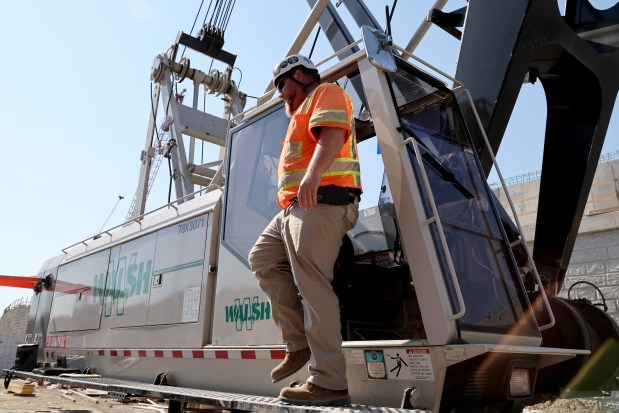
For much of their history, the Operating Engineers backed Republicans. That all changed, Poulos said, when former Gov. Bruce Rauner attempted to decimate unions in 2015.
Today they’re among the state’s most prolific donors to Democrats, according to Illinois State Board of Elections data collected by the nonprofit Reform for Illinois.
But they’re still blue-collar workers, still scarred by the collapse of Chicago’s steel mills a generation ago, still quick to take offense if they think Pritzker and other Democrats — in the name of climate change or anything else — are tossing even more jobs into the wood chipper.
Poulos touts the union’s green activism, saying he crisscrossed the state promoting wind farms and that Illinois never would have committed to shutting its coal and natural gas electricity plants by 2045 without his local’s support.
“Local 150 members are in the front of the line when it comes to reducing greenhouse gases,” Poulos said.
However, renewable power represents just 10% of Local 150’s work, Poulos said. The meat and potatoes of what it does — the highway repairs, the natural gas pipelines, and the vast warehouse and intermodal complexes — tell a different story.
They reinforce a status quo driven by carbon more than silicon, by economic growth more than environmental justice, and by suburban more than urban concerns, in part because only about a tenth of the local’s members are Black.
This status quo will only get harder for Local 150 and the rest of the state to manage as temperatures rise, freight shipments double, and the United States cracks down on PM2.5 or small particle pollution from diesel fumes.
Local 150 members operate driveable heavy construction equipment, or what they call yellow iron. This means all manner of cranes, bulldozers, backhoes, drills and pumps.
They work in small groups, in tight quarters, on rigid schedules, in all kinds of weather.
They work in highway construction sites, residential subdivisions, skyscrapers, warehouses, quarries, and landfills all across northern Illinois, northwest Indiana and southeast Iowa.
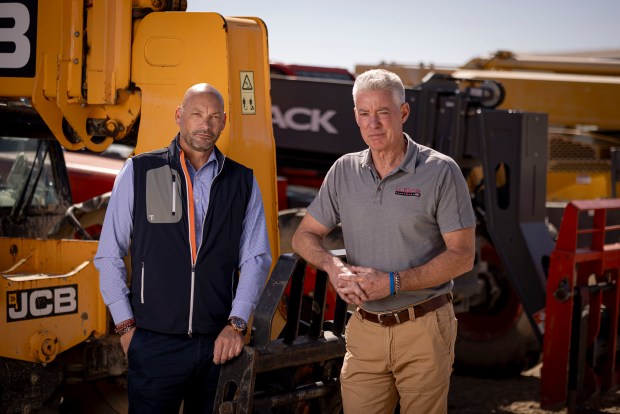
In James Sweeney, the local’s president-business manager, and Poulos, they have two of the most impactful union leaders in the state, Bruno said.
Sweeney, 64, started out operating backhoes just like his father, who arrived from Ireland in 1956.
As an organizer, he made 12-foot inflatable rats called Scabby a familiar sight around Chicago. While most other U.S. unions were shrinking, he nearly tripled the local’s membership. He negotiated a contract in May boosting hourly pay for his highway workers to $59.
Poulos, 51, began as a law clerk at the local while attending Chicago-Kent School of Law. He’s now executive director of a Local 150 affiliate called the Indiana-Illinois-Iowa Foundation for Fair Contracting.
In this and related roles, he oversees joint labor-management political action committees that make Local 150 a Springfield powerhouse.
In total over the past two decades, the Chicagoland Operators Joint Labor-Management PAC, plus the national operators’ union, have by far been the largest direct donors to Emanuel “Chris” Welch, speaker of the Illinois House, and Don Harmon, president of the Senate, according to Illinoissunshine.org, that online database created by Reform for Illinois to track political contributions.
During 2024 through mid-September, this included $1.8 million or 31% of all contributions to Welch’s candidate committee, and $1.1 million or 24% of all cash for Harmon’s, Illinoissunshine.org shows. These numbers don’t include independent PACs and superPacs.
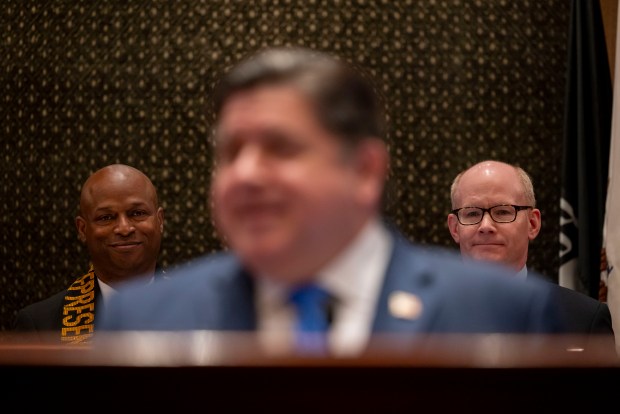
Most of the money for the Chicagoland joint PAC comes from industry giants such as Walsh Construction, Judlau Contracting and FH Paschen who, by contract, base their contributions on the number of hours Local 150 members work.
“This kind of money could buy a lot of influence,’’ said Alisa Kaplan, executive director of Reform for Illinois, which lobbies for election transparency.
Natural gas is one of the issues on which Local 150 has put its fat wallet up against Pritzker’s.
Poulos said replacing the methane-infused natural gas that heats 80% of Illinois homes with electricity will be a fine way to fight climate change.
He also said it will be expensive and take decades and that, in the meantime, it was “absolutely bananas” for Pritzker to delay repairs on gas lines that are leaking methane now and put 200 operating engineers out of work at Christmastime.
Last November, the Pritzker-appointed Illinois Commerce Commission suspended a 12-year program to modernize Chicago’s gas lines. The commission launched hearings stretching into 2025 on whether this and other natural gas investments should continue.
The decision triggered dueling television ads in which Local 150 lambasted Pritzker for failing to repair the state’s gas line “ticking time bombs,’’ and the governor praised himself for saving money for ratepayers.
In a recent mailer to Chicago residents, Local 150 also attacked aldermen who support a crackdown on natural gas hookups for new buildings in the city.
Jennifer Walling, executive director of the Illinois Environmental Council, says she works with Poulos whenever possible.
But she acknowledges limits, saying she wants to shift rapidly to a zero-carbon economy, and he needs to defend all or most of the local’s fossil fuel-related jobs.
Renewable energy helped Illinois offset the loss of coal jobs in recent years, and Walling said she hopes the same thing will happen as methane gas for home heating gets phased out.
“I know the operators don’t want to be seen as risking any jobs, but my hope is that we can see a shared opportunity to decarbonize our buildings,’’ Walling said.
For Sweeney, the local’s ability to influence public policy is anchored by its strength in the workplace.
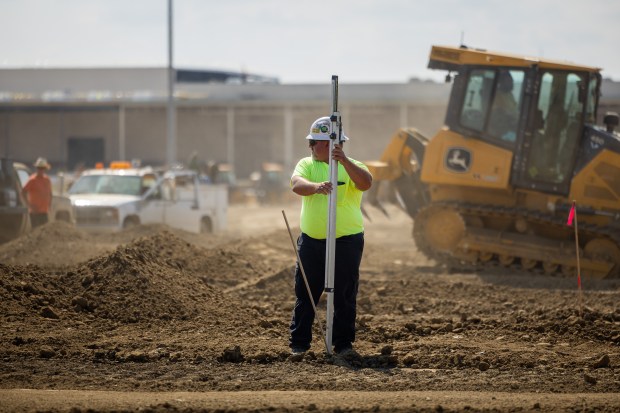
Today, Local 150 represents 99% of operating engineers in Cook County and 35% in right-to-work portions of northwest Indiana and southeast Iowa. Right-to-work laws, which allow workers to not pay dues, are designed to drain union resources. Nationwide, just 10.8% of workers belong to unions.
Maintaining these high numbers can mean playing hardball, like a seven-week Chicago quarry strike in 2022.
But in the long run, Sweeney said, the local can’t defend itself without making its members more productive. That’s why he runs a 300-acre training center in Wilmington, Illinois, 50 miles southwest of Chicago.
Today, he said, the local has 130 crane operators working at the BP oil refinery in Whiting. They take pre-assembled sections of oil refining equipment that arrive by ship, lift them up and over existing buildings, and drop them into place.
In past years, small armies of ironworkers and pipefitters would have assembled the equipment on the spot. “We’re the ones who are driving down the costs,” Sweeney said.
These lower costs help pay for, among other things, the joint labor-management PACS that Sweeney wields to defend his interests in Springfield.
His first major step came in 2016 with a so-called lockbox constitutional amendment, which prohibited lawmakers from using transportation funds for any other purpose.
Then came the 2019 Rebuild Illinois plan, which provided $45 billion for highly visible projects such as rebuilding I-80 through Will County.
Sweeney also backed the doubling of the motor fuel tax, tying future increases in the tax to inflation, and making the state’s first-ever commitment to annual investments in mass transit.
Then came what he considers his crown jewel — a 2022 constitutional amendment enshrining the right of Illinois workers to organize, even if the state elects another right-to-work governor like Rauner.
Bruno, the labor professor, said he’s unaware of any other union that’s been the principal sponsor of two state constitutional amendments.
“Business groups are engaged politically and they’ve been cleaning our clock,” Sweeney said. “This amendment sent a message to workers around the country. Do what they do. Go on the offensive.”
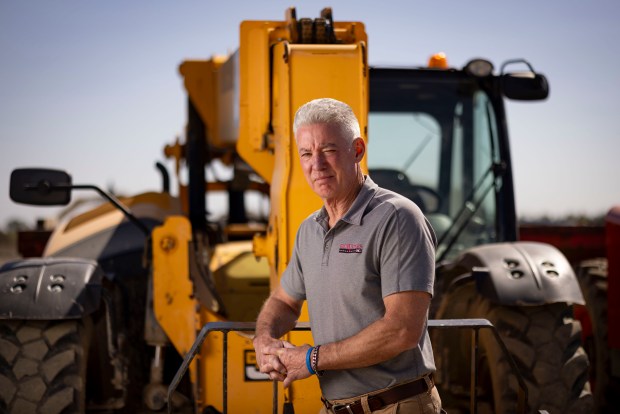
Sweeney’s campaign to rebuild the Eisenhower Expressway illustrates what he means by offense.
The Eisenhower ranks routinely as one of the most congested highways in the United States. It’s been crumbling year after year, Sweeney said, because nobody wants to pay for what would be the costliest highway reconstruction in Illinois history.
So two years ago, Sweeney took $200,000 from a joint labor-management fund he controls and started a nonprofit lobbying group called the I-290 Blue Line Coalition.
The trustees, who include three Local 150 union officers and representatives from the Commercial Club of Chicago and the main road-building employer group, embraced an array of innovations to broaden the project’s appeal.
These include rebuilt Chicago Transit Authority tracks, more express bus lanes, and a fourth vehicle lane in each direction requiring a wider freeway from Austin Avenue to 25th Avenue in Maywood.
The coalition also wants to build a cement cap over portions of the 13 miles of freeway between downtown and Elmhurst, Poulos said. Trains, cars and trucks would run below the cap and expanded green spaces, bike lanes and commercial buildings would be built on top.
The coalition has steadily gained support for the project, which would also create jobs for hundreds of union workers for several years.
Pritzker has authorized $1.3 billion so far. The federal government contributed $208 million to reconnect communities torn apart when the freeway opened in 1955 and to fix transit bottlenecks and flooding in Maywood.
That leaves a $5 billion gap Poulos is trying to fill.
As a start, he said, the project will need a managed or so-called Lexus lane so drivers can opt to pay extra for faster commutes.
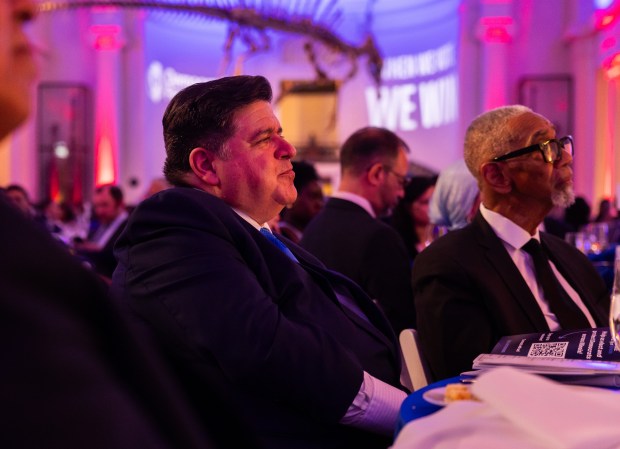
The Pritzker-appointed Illinois Tollway could sell bonds for the project and collect the tolls, Poulos said. Another possibility is a public-private partnership like a toll road that Local 150 and others recently opened in Joliet.
Pritzker balked at privately managed toll lanes for I-55 through Little Village last year, but Poulos expects the laws of economic gravity to change the governor’s mind.
“Infrastructure is so expensive that, if you’re relying on public tax dollars, the pot is just not big enough,’’ Poulos said. “You’ve got to turn to the private marketplace.’’
Many of these ideas are controversial.
Scott Bernstein, co-founder of an environmental group called Center for Neighborhood Technology, wants more public engagement before the I-290 Blue Line Coalition heavyweights cement the state’s plans in place.
Bernstein doesn’t want the state’s road-building ethos to blot out other possibilities, such as extending the Blue Line to job-rich Oak Brook and shifting more freight from trucks to trains.
“Whatever the state’s goals for reducing greenhouse gases and air pollution, they can’t be met without cleaner vehicles,” Bernstein said. “But you also have to reduce the volume of traffic.”
The environmentalists keep trying because transportation remains the state’s largest source of greenhouse gases.
Poulos said he’ll continue to stall electric vehicle mandates until the state can replace the $3.6 billion it gets each year from the fuel tax.
As part of the coming debate on transit reform and finances in Chicago, Local 150 will propose a pilot program to tax Illinoisans based on how many miles they drive rather than how much fuel they buy.
Poulos said the state would need five years to roll out this system. In the meantime, he said, electric vehicle mandates will have to wait.
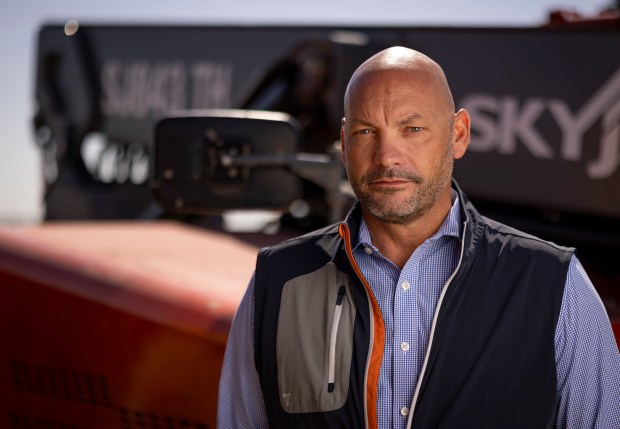
And that’s assuming the U.S. presidential election doesn’t scramble future plans for Local 150 and everybody else.
Sweeney says he has no doubt a reelected Donald Trump could threaten the union movement by, among other things, pushing for a national right-to-work law or the end of prevailing wage requirements that bar employers from competing by slashing wages.
“I still have my Irish citizenship and I’ve got it for all my family,” he said. “He scares me that much.”
But when it comes to a choice between the former president and Kamala Harris, he expects a split vote among his members, whom he describes as mostly “white guys in the construction industry.”
He said many of his members consider presidential voting their personal business, unlike union meetings. Some are focused on their freedom to own guns or not wear face masks.
But Sweeney said Harris also makes him nervous when she hangs around Silicon Valley billionaires. It reminds him, he said, of former President Barack Obama.
“When I got out of high school, I went to work in steel mills, the slag industry. I watched Republic Steel close, South Works close, Wisconsin Steel close,” Sweeney said.
“Trump was the first one to actually talk about it, to say `we’re going to put tariffs on imports; we’re going to bring manufacturing back,’” he said. “The Obama administration spoke a great game but never did anything for us.
“Biden has been the best president we’ve had since Roosevelt for labor,” Sweeney said. “I’m hoping and praying Harris is going to pick up his mantle and run with it.”
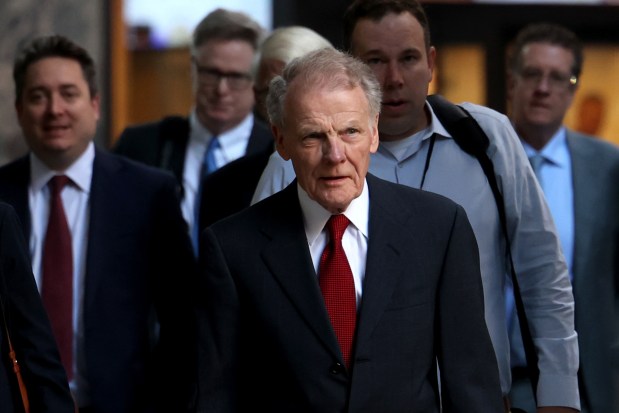
And then there’s Madigan.
Sweeney has known the former speaker since growing up in Queen of the Universe, a Catholic parish 2 miles southeast of Midway Airport, in the heart of Madigan’s beloved 13th Ward.
Sweeney said he’d be shocked if Madigan gets convicted in his bribery trial.
The former speaker was charged in March 2022 and accused of conspiring to participate in bribery and extortion from 2011 to 2019. According to the indictment, he used his elected office and political power for personal gain.
“He wouldn’t accept a T-shirt from me,” Sweeney said. “I saw what he had in his office. A Rolodex. There ain’t no computer. There are no texts. He’s about as old school as you can get.”
In June, the U.S. Supreme Court narrowed the government’s chances of convicting Madigan by declaring that the U.S. bribery statute applies only to specific quid pro quo arrangements and not to what the court described as gratuities.
Local 150 attorneys filed an amicus brief in the Supreme Court case, before the ruling, describing the bribery statute as vague.
Sweeney said he authorized the brief not just to help Madigan but also himself.
He said he needs to understand the rules because he needs to follow them in a world where everyone around him is looking for work.
Sweeney said the last thing he wants to do is damage his father’s reputation. “It scares me.”
In the meantime, he’s got a membership that’s counting on him to stay a step ahead.
Sweeney said the local’s salvation lies in controlling, maintaining, and repairing future generations of construction equipment that will be designed around the use of artificial intelligence.
Contractors are already developing self-driving bulldozers and backhoes that can dig the foundations for a wind farm without human operators, he said.
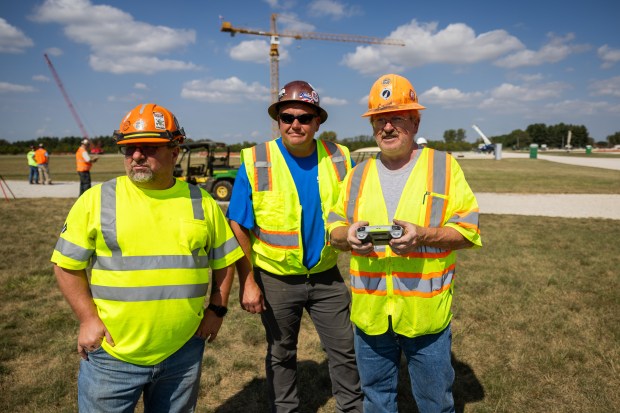
According to George Santos, the business agent who runs the Wilmington training center, 150 of the local’s members have already trained to pass the Federal Aviation Administration’s remote pilot certification test for small drones.
That doesn’t mean they’ll be delivering dog treats via Amazon drones any time soon.
But Santos believes every big construction site will soon deploy its own fleet of drones to, among other things, conduct safety inspections on cranes and other equipment before work each day. And Local 150 is running training programs now, he said, to make sure its members are the ones doing the deploying.
Sweeney is all-in on data centers. He said they’re an AI-driven trend so vast that Illinois will need 40% more electricity just to run data centers on the drawing board now.
After Local 150 built its Wilmington training center, it also obtained land next door that had been part of a decommissioned U.S. Army arsenal site. Sweeney said the local will use this land to build what could be a $1 billion data center.
The shift to Wilmington further removed Local 150 from Chicago. It weakened one of the city’s potential pathways to high-tech prosperity and environmental justice.
However, Wilmington could turn out to be the economic fortress that saves Local 150.
“We own 800 acres in Wilmington that we’re going to develop into a data center, and then we’re going to keep it as part owners,” Sweeney said.
“That money will go into a strike fund so nobody can ever starve our members out.”
Search
RECENT PRESS RELEASES
Related Post



